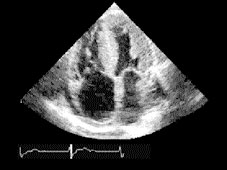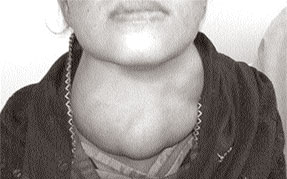|

Heart ultrasound
Risk of heart attack, death in HIV patients can be
predicted:
An ultrasound test can tell if people with the human immunodeficiency
virus (HIV) and heart disease are at risk of heart attack or death,
according to new research reported in Circulation: Cardiovascular
Imaging, an American Heart Association journal.
Stress echocardiography, better known as a “stress echo,” is an
ultrasound of the heart during rest and stress that determines risk of
heart attack and death in patients with known or suspected blockages in
the blood vessels supplying the heart.
|

Ultrasound scan report |
People with HIV are at increased risk for accelerated blockages and
subsequent heart attack or death.
“We looked at whether stress echo can help predict risk in a
high-risk group, HIV patients with known or suspected heart disease and
determine whether they have a high or low risk of heart attack and death
in the future,” said Farooq A. Chaudhry, senior author of the study and
associate professor of medicine.Chaudhry and colleagues performed a
stress echo and analysed follow-up data on 311 HIV patients (average age
52 years and 74 percent male) with suspected or known heart disease.
Among the patients studied, 26 percent had an abnormal stress echo.
During the average 2.9-year follow-up, 17 non-fatal heart attacks and
14 cardiac deaths occurred.
The prognosis was good for HIV patients who had normal stress echo
findings, researchers said. These patients’ average risk for heart
attack or death was less than 1 percent per year - the same as that of
the general, healthy population. The risk of heart attack and death rose
significantly for HIV patients with abnormal stress echo findings. Their
average risk was nearly 12 percent per year - 10 times higher than that
of the normal population and more than three times that of people
without HIV who have an abnormal stress echo.
The cumulative survival for HIV patients with normal stress echo
results was 100 percent at one year and 98 percent at four years, which
is in stark comparison to 92 percent at one year and 62 percent at four
years in those patients with an abnormal stress echo.
“Although we did not study which treatments are most effective for
these patients, HIV patients who have abnormal stress echocardiography
should probably be monitored and treated more aggressively to prevent
heart attack and death,” said Chaudhry
“Conversely, patients with a normal stress echo might not need such
aggressive interventions.”
Source: Maggie Francis American Heart Association.
Iodine deficiency
Most common cause of preventable brain damage:
Micronutrients enhance the nutritional quality of food and improve
the health condition of the body. They are required in little quantities
in a diet. But there are some adverse effects to the body if they lack
in the diet and they are called micronutrient deficiencies. These
deficiencies may not be identified easily at their early stages (subclinical),
but at later stages (clinical). That is the danger of micronutrient
deficiencies.
Iodine is one of the micronutrient deficiencies that had become a
public health problem in Sri Lanka. According to the national survey
1986, the total goitre prevalence was 18.2%.
With the launch of ‘Universal Salt Iodization’ the total goitre rate
has decreased up to 3.8% by 2005. Then furthermore it is not a public
health problem but it may prevail hidden in some pockets of areas in Sri
Lanka, especially Western, Central and Uva provinces (according to the
report iodine Nutrition Status in Sri Lanka, MRI 2005) That is why we
should still be aware of that....
|

Goitre - swelling of the throat |
What is iodine deficiency?
It is very easy to gain required amount of iodine by iodized salt.
According to Sri Lankan recommendation, MRI it is 150 micrograms for
normal person per day. You have to take only a half a tea spoon of
iodized salt to fulfill your daily iodine requirement. If you are unable
to get that sufficient amount of iodine, it creates iodine deficiency.
If the intake is very much less, it may cause disorders in your body.
Who may suffer from iodine
deficiency?
From foetus to elderly, all the age groups may suffer from iodine
deficiency. But it may be crucial during pregnancy and foetal stages. If
a mother is limited in her own production of thyroid hormones on account
of iodine deficiency the foetus will quite vulnerable to iodine
deficiency. Females have been found more vulnerable for iodine
deficiency disorders than the males.
How goitre occurs
Iodine is the raw material for thyroid hormone (thyroxine,
triodothyronine) production in your body (by thyroid gland). When there
is an iodine deficiency in your body, the production of thyroid hormones
is reduced and you may get hypothyroidism.
Those reduced hormone levels are not sufficient for your body
functions and then the body tries to produce thyroid hormones more and
more. It leads to an enlargement of thyroid gland and is called GOITRE.
It is the commonly used clinical symptom of iodine deficiency in adults.
It can be identified by a skilful person by touching the neck (by
palpation).
Cretinism is the severe form of damage of iodine deficiency
characterised by a severe mental retardation. Sometimes myxedematous
form is the other extreme end. That can be seen among children who have
been born with severe iodine deficiency in their mothers. They may have
problems with nervous system, muscle & bone development as well as
metabolism of the body. Their brain has not developed and matured well.
Therefore they have lot of problems in thinking, speaking and moving
their hands and legs as they want. They will not perform well in their
education. That will end up in poorer performances in most of the works
at their later life.
In adults, iodine deficiency may be responsible for weight gain. Some
serious health effects can occur in pregnancy. Iodine deficiency during
pregnancy may cause increased rates of abortions. Those mothers will
give birth to stillborn babies and problematic children. Most of the
time mothers may suffer from less or no pregnancy due to iodine
deficiency. It is a critical point that you should give your attention
carefully.
What are the symptoms?
As mentioned earlier, goitre is the common symptom of iodine
deficiency. But some other symptoms are there, such as slowness of
movements, hoarsening of the voice, elevated blood cholesterol levels,
cardiac insufficiency, cold intolerance, obesity, increased sensitivity
to some drugs (eg. Morphine), etc.
Iodine supplementation is done early in the second drimester to
prevent most of the damage. If it is delayed, the neonates may have
permanent impairments in nervous system.
Impaired performances can be corrected by administration of iodine
but the nerve and the cognitive deficits are not. Then the problems of
moving hands and legs, speaking and thinking may not be reversed even if
they are treated with iodine or thyroid hormones.
But the mothers may improve their fertility by iodine or thyroid
hormone replacement therapies.
Prevention is better than cure...
Iodine deficiency is the most common cause of prevantable brain
damage, mental retardation and psychomotor development in the world.
Then if you pay further attention, those serious health complications
can be completely removed from Sri Lanka.
D.L.P. Peiris - Wayamba University of Sri Lanka.
‘Popular’ TV shows teach children fame is No. 1 value
Fame is the No. 1 value emphasised by television shows popular with
9- to 11-year-olds, a dramatic change over the past 10 years,
psychologists report in a new study.
On a list of 16 values, fame jumped from the 15th spot, where it was
in both 1987 and 1997, to the first spot in 2007. From 1997 to 2007,
benevolence (being kind and helping others) fell from second to 13th,
and tradition dropped from fourth to 15th.
The study assessed the values of characters in popular television
shows in each decade from 1967 to 2007, with two shows per decade
evaluated, including “Andy Griffith” and “The Lucy Show” in 1967,
“Laverne & Shirley” and “Happy Days” in 1977, and “American Idol” and
“Hannah Montana” in 2007.
“I was shocked, especially by the dramatic changes in the past 10
years,” said Yalda T. Uhls, a doctoral student in developmental
psychology and the lead author of the study. “I thought fame would be
important but did not expect this drastic an increase or such a dramatic
decrease in other values, such as community feeling. If you believe that
television reflects the culture, as I do, then American culture has
changed drastically.”
Community feeling (being part of a group) was the No. 1 value in
1967, 1977 and 1997, and it was the No. 2 value in 1987, the study
found. By 2007, however, it had fallen out of the top 10, to 11th.
“The rise of fame in preteen television may be one influence in the
documented rise of narcissism in our culture,” said the study’s senior
author, Patricia M. Greenfield, a professor of psychology. “Popular
television shows are part of the environment that causes the increased
narcissism, but they also reflect the culture.
They both reflect it and serve as a powerful socialisation force for
the next generation.”
The top five values in 2007 were fame, achievement, popularity, image
and financial success. In 1997, the top five were community feeling,
benevolence (being kind and helping others), image, tradition and
self-acceptance. In 2007, benevolence dropped to the 12th spot and
community feeling fell to 11th. Financial success went from 12th in 1967
and 1997 to fifth in 2007.
Source: Stuart Wolpert
University of California.
Before animals first walked on land, fish carried gene program for
limbs
Genetic instructions for developing limbs and digits were present in
primitive fish millions of years before their descendants first crawled
on to land, researchers have discovered. Genetic switches control the
timing and location of gene activity.
When a particular switch taken from fish DNA is placed into mouse
embryos, the segment can activate genes in the developing limb region of
embryos, University of Chicago researchers report in Proceedings of the
National Academy of Sciences. The successful swap suggests that the
recipe for limb development is conserved in species separated by 400
million years of evolution.

“The genetic switches that drive the expression of genes in the
digits of mice are not only present in fish, but the fish sequence can
actually activate the expression in mice,” said Igor Schneider, lead
author on the paper. “This tells us how the antecedents of the limb go
back in time at every level, from fossils to genes.”
The genetic hunt was inspired by a famous fossil find - the 2004
discovery of the transitional fossil Tiktaalik in the Canadian Arctic by
a team led by Neil Shubin of the University of Chicago.
A transitional species between fish and the four-legged tetrapods,
Tiktaalik possessed fins containing a skeletal structure similar to the
limbs of later land-dwelling animals.
Those similarities - particularly the wrist and hand-like
compartments present in the fins of Tiktaalik and its peers - inspired a
laboratory experiment to look at the homology, or shared physical and
genetic traits, of fish and limbed animals.
“This is really a case where knowing something about the fossils and
the morphology led us to think about genetic experiments,” said Shubin,
PhD, the Robert R. Bensley Professor of Organismal Biology and Anatomy
and senior author of the study.
“Tiktaalik and its cousins showed us that this limb compartment is
not an utter novelty in tetrapods, as was thought for a long-time. So an
antecedent of that program must exist.”
The research team compared a genetic switch region called CsB, known
to regulate limb development in humans, with similar regions in mice,
chickens, frogs, and two fish species: the zebrafish and the skate.
Because the last common ancestor of all these species pre-dates
Tiktaalik-like “fishapods,” the comparison offered a glimpse at biology
before animals made their first steps on land.
Schneider and colleagues compared the CsB regions from all five
species and found that certain sequences were shared between the fish
species and the tetrapods.
The conservation allowed the researchers to try swapping switch
sequences between species to see if they could still drive gene
expression in the fin or limb.
Remarkably, mouse CsB could turn on gene expression at the outer edge
of the developing fin region of zebrafish, and both skate and zebrafish
CsB were capable of activating gene expression in the wrist and proximal
digits of the mouse limb.
“These sequences function in these organisms despite 400 million
years of separation,” Schneider said.
“The homologies that are perhaps not evident by morphology - just
comparing a hand and a fin - can be traced back to the genome, where you
find that the regulatory regions that control the making of those
structures are actually present and shared between these organisms.”
Source: Robert Mitchum University of Chicago Medical
Centre.
A case for a Dengue Day
by Lionel WIJESIRI
The epidemic of dengue has again resurfaced in Sri Lanka. with
thousands of patients reporting in different public and private clinics
and hospitals.
Government as well as civic authorities are facing a lot of problems
in tackling this scourge of dengue virus.
Dengue fever is the most common of all arthropod born diseases. It
occurs in most of the tropical countries. Over half of WHO member states
representing a total of 2000 million are currently threatened by Dengue.
According to our Epidemiology Unit, up to end June there were over
9000 confirmed dengue cases and out of them 73 had died. The most
affected districts were Colombo, Gampaha, Kalutara, Batticaloa,
Kurunegala and Ratnapura.
As a preventive campaign, Government declared a National Dengue
Control Week from June 20 - 26. Reports indicated that nearly 10,000
mosquito breeding places were found and destroyed during this period. It
really was a good successful exercise.
Individual Inspections
However, medical experts agree that the basic rule of Dengue control
is that individuals should do inspections of their premises - homes,
businesses and schools - weekly to ensure that there is no stagnant
water and no containers that could contribute to mosquito breeding.
It is therefore imperative that the community, including individuals,
groups and private sector entities join in partnership with the Ministry
of Health in the prevention and control of Dengue.
It is easily said than done. What is the best strategy to mobilize
people and institutions to come forward in one lot? I believe the
Government should declare a Dengue Day (or D- Day). It will be good
concept to organize a mass mobilisation of city residents to conduct
dengue control activities on one specific day.
This day will be registered in the history of the Sri Lankan public
health system as the date of the first large-scale social mobilisation
activity carried out in the fight against dengue in Sri Lanka. D-Day
will involve all citizens in the country field actions using
insecticides (chemical control).
We have seen in the past that dengue field staffs who conduct
house-to-house inspections had always been insufficient in stemming the
proliferation of breeding. In our country, since 90% of the foci of the
mosquito are found in and around the house, only the adoption of
collective and simultaneous domestic actions for prevention will be able
to produce a rapid impact on dengue. This was the premise for D-Day.
D-Day will be a massive house-by-house inspection to eliminate or
treat any object that could be transformed into an active breeding site
of dengue mosquito.
The success of this large- scale social mobilization activity depends
upon partnerships between governmental entities, most importantly
between the various levels of government and other nongovernmental
organisations (NGOs).
Point Zero
Although the Ministry of Health has promoted dengue prevention and
control campaigns, a D-Day can be established as ‘point zero’ in order
to increase general consciousness that combating dengue is everyone’s
responsibility, including the Central, Provincial, and Local levels and
residents, all of whom must adopt, as part of their domestic routines,
basic mosquito prevention and control actions.
In order for D-Day to take place, the MOH, on behalf of the Central
Government, should request the support of the local governments, which
then will join in partnerships with private industry and NGOs to
mobilise the population.
The message to be delivered is simple. It just takes 15 minutes a
week to keep the mosquitoes away. Simply take that time to look around
your premises to identify anything that can hold ‘clean water’.
Then let commonsense kick in. Eliminate those breeding places
promptly. Simple as that! ASEAN countries proved it could be done. |

